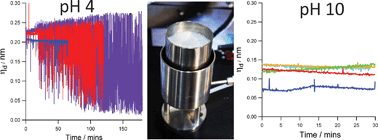Effects of bulk aggregation on PEI–SDS monolayers at the dynamic air–liquid interface: depletion due to precipitationversus enrichment by a convection/spreading mechanism†
Abstract
The dynamic interfacial

* Corresponding authors
a
Institut Laue-Langevin, 6 rue Jules Horowitz, BP 156, 38042 Grenoble Cedex 9, France
E-mail:
campbell@ill.eu
Tel: +33 476207097
b
Department of Chemistry, Durham University, South Road, Durham, UK
E-mail:
annaangussmyth@gmail.com
Tel: +44 (0)1793442572
c Institute of Chemistry, Eötvös Loránd University, P. O. Box 32, Budapest 112, H-1518 Hungary
The dynamic interfacial

 Please wait while we load your content...
Something went wrong. Try again?
Please wait while we load your content...
Something went wrong. Try again?
A. Angus-Smyth, C. D. Bain, I. Varga and R. A. Campbell, Soft Matter, 2013, 9, 6103 DOI: 10.1039/C3SM50636C
To request permission to reproduce material from this article, please go to the Copyright Clearance Center request page.
If you are an author contributing to an RSC publication, you do not need to request permission provided correct acknowledgement is given.
If you are the author of this article, you do not need to request permission to reproduce figures and diagrams provided correct acknowledgement is given. If you want to reproduce the whole article in a third-party publication (excluding your thesis/dissertation for which permission is not required) please go to the Copyright Clearance Center request page.
Read more about how to correctly acknowledge RSC content.
 Fetching data from CrossRef.
Fetching data from CrossRef.
This may take some time to load.
Loading related content
